| Much Adu about Apple Pie, Pilgrimage to Jomosom
I had
been in Nepal for many months, living, teaching,
working, learning, but
not trekking. Well, visiting places for volunteer work and walking from
one place to another for necessity doesnít usually qualify as trekking
in the handbook, but you do get to see a different side of Nepal. But
for all my time here, I still had not seen the famed trails of Jomosom,
the single most trekked path in Nepal nor tasted the famed apple pie of Marpha,
which seems to compell dramatic proclamations attesting to its revered
status in backpacker lore, much like full moon parties and bhang lassis. The pilgrimage to Muktinath beckoned and I was
eager to discover what drew trekkers here, to see the side of Nepal that
most people see, for how could thousands of trekkers be wrong.

Myself, Prakash,
Devi and Deepak and below, Ken and Lisa
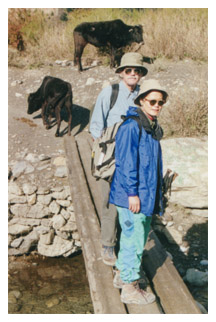 What
a motley group we made. I tagged along with my friends who were guiding
and portering for a lovely couple from California. There was Ken, the
gentlemen adventurer on the other side of seventy and his wife Lisa, a
gregarious Taiwanese woman, which like many Asians, you canít quite
tell how old she is. Decked out in their state of the art REI gear, they
were jet set to go, and hired Devi as a guide and Deviís brother,
Prakash and friend Deepak as porters. Worried about overloading one,
they hired two because the more the merrier. And finally there was me,
the tag-along in my kurta, the long tunic and loose pants outfit
that all young women wear and sandals. Not a stitch of micro-fiber to be
seen, but I was as undaunted as I was unprepared. What
a motley group we made. I tagged along with my friends who were guiding
and portering for a lovely couple from California. There was Ken, the
gentlemen adventurer on the other side of seventy and his wife Lisa, a
gregarious Taiwanese woman, which like many Asians, you canít quite
tell how old she is. Decked out in their state of the art REI gear, they
were jet set to go, and hired Devi as a guide and Deviís brother,
Prakash and friend Deepak as porters. Worried about overloading one,
they hired two because the more the merrier. And finally there was me,
the tag-along in my kurta, the long tunic and loose pants outfit
that all young women wear and sandals. Not a stitch of micro-fiber to be
seen, but I was as undaunted as I was unprepared.
For more info on Devi and Prakash,
check out Meet the Sapkotas
Day 1: Flight to Jomosom (20 min.)
and trek to Kagbeni (2.5 hours)
It
was early March when we set out and a fine time to be trekking. Devi
arranged for the ACAP permits and flights to Jomosom leaving the next
morning at 7:00am. It was to be Prakashís first plane flight and he
could barely wait. At Pokharaís small airport, we had our bags
weighed, and for a moment, I thought they might ask us to hop on the
giant super-scale. I was all too familiar with this airport in fact. The
year before, I had spent four consecutive mornings trying to get a
flight out to Jomosom during the early monsoon, waiting from 6:15 am til
almost 11:00 hoping that something might part the rain swollen clouds in
Pokhara or slow the impending high winds in Jomosom. Well...alot of card
games were played. I taught my Nepali friends how to play spite and
malice and it drew a huge crowd. Back to the future...
We
loaded on to a Shangri-La Airlines plane. On one side was two seats, the
other a single one. The pilot was outside helping to load the hatch,
while the one stewardess offered up a try of candies next to what
looked like cotton candy. We pulled off a small
amount, and following our fellow passengers lead, wadded it up and stuffed into our ears to cut the roar of
the engines. Her sole task completed, she sat back and calmly
strapped herself in. I looked down at the seat belt that strapped me
into a glorified metal folding chair and thought nostalgically about
seat-back trays and headrests. As our plane gently rose above the
surrounding foothills of Pokhara, I took in the details of the rice
terraces and homes that were so close beneath us and then the blinding
whiteness of the Annapurnas before us.
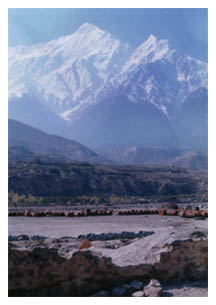 Jomosom
Airport Jomosom
Airport
After a short fifteen minutes, we
all too quickly began to descend into a small fold in the landscape and
landed amid a runaway demarcated with rusted metal barrels and tires
that, along with a small house, was the whole of the Jomosom airport.
Squinting under the glaring blindness of the Annapurnas that loomed
before us, we grabbed our bags and without even visiting the
airport building, headed out to the main street.
Prakash
and Deepak wrestled with trying to figure out how to carry two large but
relatively light duffle bags and a sleeping bag each. They looked so
funny trying to wear the duffle bags as a backpack, with its too short
straps pulling their arms out to each side, but that soon proved too
cumbersome when their armpits started chafing. They finally settled on
carrying them Nepali style, with the strap resting across their forehead
and the sleeping bag nestled behind their head. Meanwhile, my own bare
essentials fit into one small daypack, no muss, no fuss.
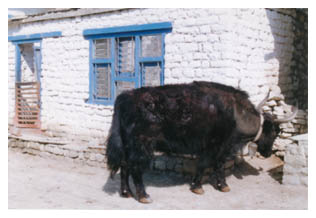
Jomosom
is the district headquarters and the magnet village for the surrounding
areas as far as Upper Mustang. Here, goods could be traded and bought
and the trails were a constant mix of trekkers, yaks and donkey trains. It was
also the area base for the Royal Nepalese army and the barracks on the
outskirts of town fielded a splendid show of pomp, with their own Gurkha
version of the changing of the guard.
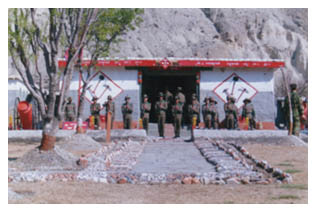
We
immediately headed for Kagbeni, which is about two and half hours away
and a very easy walk with little incline. There, we checked into a lodge
and I set out to explore. Kagbeni appears virtually unchanged, a small
remote fortress enclave that overlooks the Kali Gandaki river as it
flows out of Upper Mustang, the forbidden kingdom.
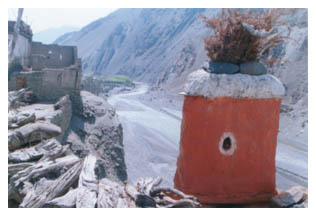
View from Kagbeni village
overlooking the Kali Gandaki River
At
this point, the river is large swath of trickling flows that begins to
amass power down lower, as numerous waterfalls feed into it in the great
gorge between Dhaulagiri and the Annapurnas. But we are still above that
and high on the great Tibetan plateau. Kagbeni is as far as a tourist
may go without purchasing a special permit to enter Mustang. At a
beginning rate of $700 for ten days, Mustang manages to remain the
forbidden kingdom, although trade from China may soon change all that.
At the very northern point of the village sits the lonely ACAP official
who guards the only trail into Mustang. Heís eager to chat and I sit
awhile with him. Heís not from around here and bummed as all to get
such a remote posting. I eventually leave him to his snoozing.

Kagbeni village itself is a time warp. A maze of dense paths lead in and
out, over and under the village itself, enclosed by the tall walls of
the ancient fortress. The walls are built atop a strong rock base while
rooftops are layered with enough wood to last the harsh Himalayan
winters.
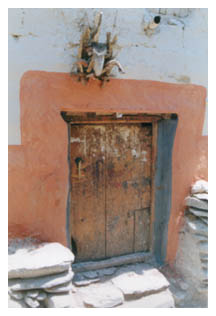 The
mud walls in-between are plastered white and gaily decorated with red
wash and doors topped with ram skulls assemblages. While Nepalis to
begin with, are somewhat height challenged in relationship to
Westerners, one might guess by the height of many of the doors in
Kagbeni that Nepal was actually the home of the Oompa Loompas. The
mud walls in-between are plastered white and gaily decorated with red
wash and doors topped with ram skulls assemblages. While Nepalis to
begin with, are somewhat height challenged in relationship to
Westerners, one might guess by the height of many of the doors in
Kagbeni that Nepal was actually the home of the Oompa Loompas.
3 foot tall doorway
The pathways are
cobblestone and often lead directly into someoneís living space. Space
is shared by animal and people alike, and itís not unusual to see
someone lead a yak or a herd of goats into their home for the night.
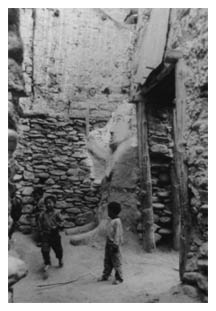 Around
one corner, a large god figure has been sculpted from mud, his face
eerily reminiscent of the Easter Island idols. The remains of
yesterday's puja, by the looks of the wilted petals on the small red
flowers lay between his protruding feet. Children run excitedly through the small pathways, perhaps playing their
own version of hide and seek. Around
one corner, a large god figure has been sculpted from mud, his face
eerily reminiscent of the Easter Island idols. The remains of
yesterday's puja, by the looks of the wilted petals on the small red
flowers lay between his protruding feet. Children run excitedly through the small pathways, perhaps playing their
own version of hide and seek.
I canít imagine a better place for it.
On the outskirts of this small village there are small plots of land,
encased within short stonewalls where locals grow fruits and vegetables
hardy enough for the harsh weather and altitude. In the distance, you
can see herds of goats roaming the hillsides seeking the sparse
vegetation. I sat in front of a local store, sketching the durbur square
of Kagbeni. Three local young women hung out of the doorway and called
to me to come and talk with them. Children crowded around to watch my
sketch come to life. They seemed most excited by matching some detail in
my picture to real life. When I drew a passing cow on his way home,
permanently capturing in my sketch for all posterity a fleeting moment
in time, it delighted them all the more.
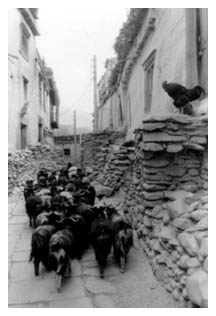 Later
that evening, a rooster watched a parade of goats as they came home,
tired after a day of wandering the dry, dusty Tibetan plateau. Later
that evening, a rooster watched a parade of goats as they came home,
tired after a day of wandering the dry, dusty Tibetan plateau.
As for us, after a dinner of dhal
bhat, the Nepali staple of curried vegetables, lentil gravy, rice and
spicy pickled relish, we settled down to sleep soundly, under a load of
thick Nepali cotton blankets.
next
| Day 1
|
